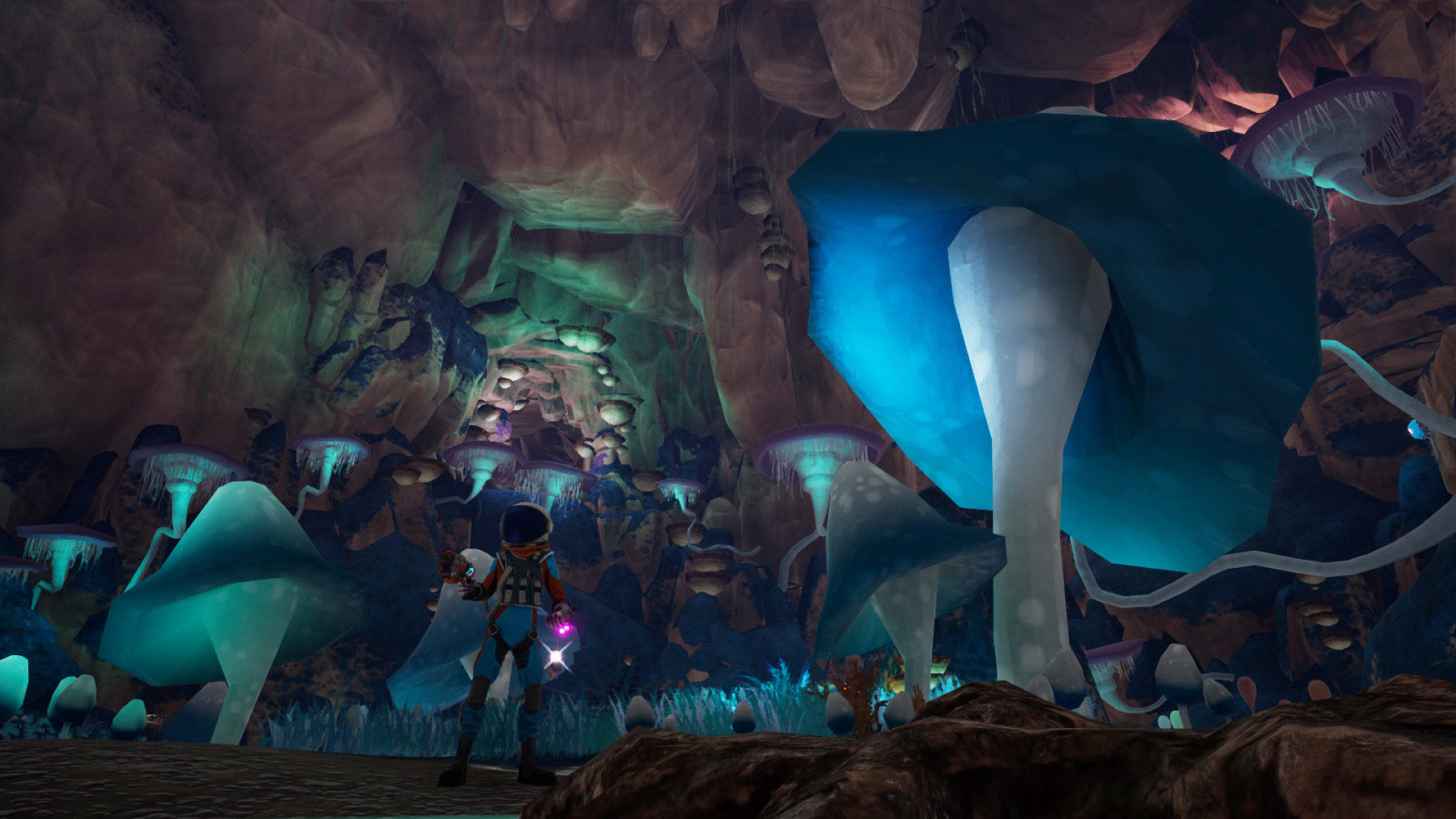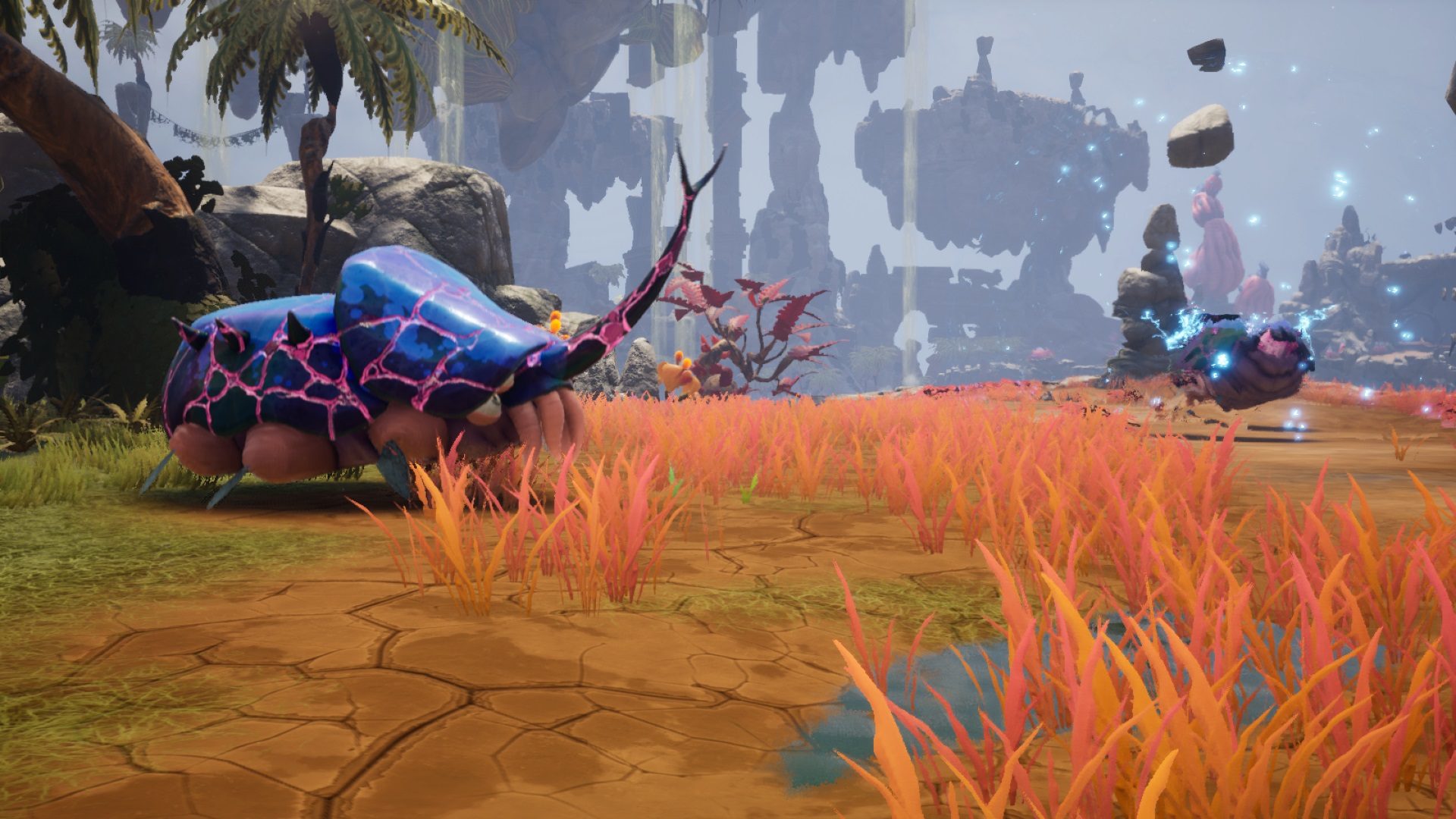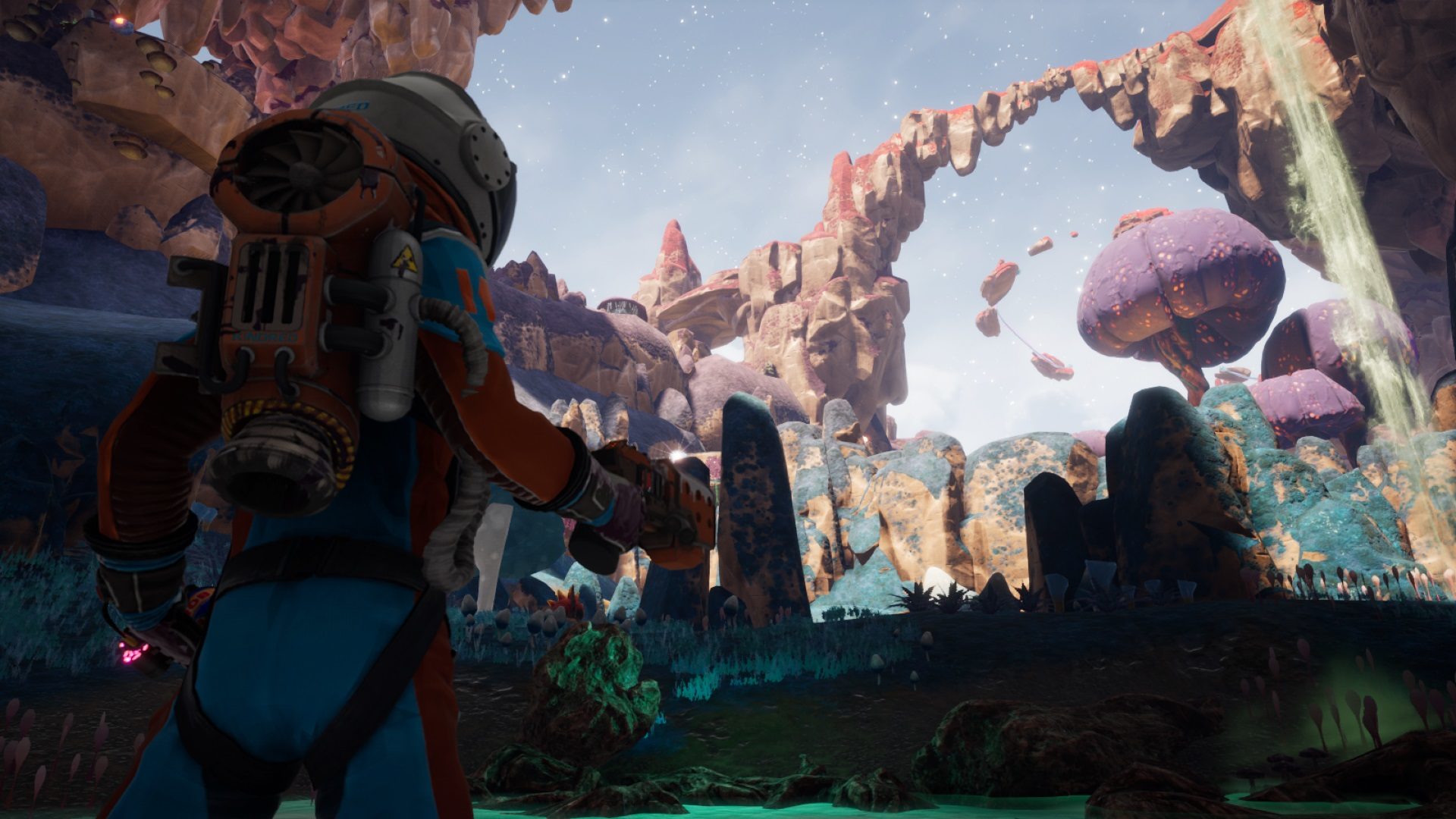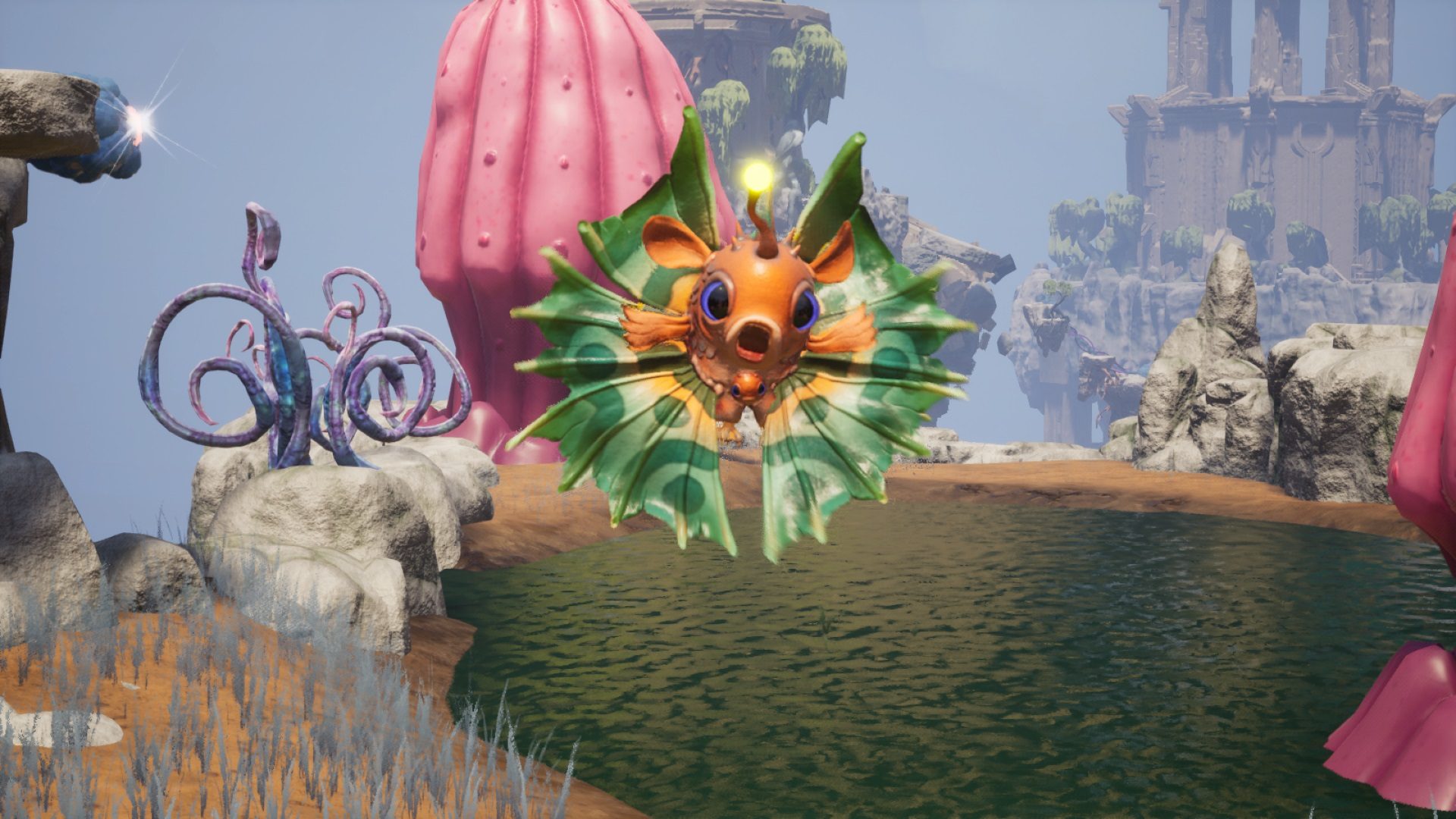Journey to the Savage Planet feels like it was made by people who love video games. I’m sure most people who make games like games. They maybe even likelike games. But the folks at Typhoon Studios obviously love video games. More importantly, they also love the player.
To say that there’s been a shortage of video games that truly feel like adventures probably sounds ridiculous, considering the last two decades of open-world series starring assassins and cowboys and witchers. But those games tend to take the Herman Melville approach to adventure by filling out our experience with a thousand pages on how boats work.
When it comes to cultivating a sense of adventure, Journey to the Savage Planet is the Raiders of the Lost Ark to other games’ Moby-Dick. Even the title sounds like pulp.

You play as an employee of Kindred Aerospace, the “4th Best interstellar exploration company,” and your task is simple: Chart the uncharted planet of AY-26 by cataloging its flora and fauna, and determine whether or not it’s suitable for human habitation. You quickly discover, however, that you aren’t the first intelligent life to have stepped on the planet’s surface.
That setup might make the game’s plot sound a little more nefarious than it actually is. Truthfully, while the signs of another civilization do pop up here and there, and even though figuring out who or what that civilization is drives the game’s main questline, you’re not going to be running into a technologically advanced, murderous, humanoid alien species. Instead, Savage Planet focuses almost exclusively on exploration, puzzle-solving, platforming, and some light combat against AY-26’s main inhabitants: its cartoonish and hilarious wildlife.
AY-26’s world design is surreal in the same way that Super Mario 64’s levels are surreal, which is especially interesting considering the game’s sci-fi baseline. No Man’s Sky might have goofy-looking animals and oddly colored grass, but the flora and fauna in that game are based on the cold calculations of a computer. Outer Wilds might have a highly authored and meticulously clockwork solar system, but moving between and around its planets is no damn fun. Unlike those settings, AY-26 shares more in common with the worlds of the 3D platformers of yesteryear, with floating islands, hidden nooks and breakable walls, grappling hooks and swingable gaps, a multitude of collectibles, antagonistic wildlife, and a gosh-darn quadruple jump (eventually). It’s a purposeful, lively, and carefully constructed playground.

Developer Typhoon Studios understands that world design and discovery is an opportunity to have a playful conversation with the player experiencing it. When I come upon a new species in No Man’s Sky, I don’t necessarily feel like the game cares that I found it. Savage Planet cares very deeply about me not only finding a new species, but also what that new species means to me as a player. Not only is scanning each one of the game’s 100 variations of plants and animals required to fully complete the game, but doing so will often give you a humorous description that’s in line with the game’s absurdist, anti-capitalist satire. More significantly, most of the wildlife (I balk at calling them “enemies”) is where it is for a very specific reason—either to telegraph to the player what ability they will unlock next or to test the player’s aptitude with that newfound ability. Some are just there to throw you a curveball, like the Sproutlook, which requires a mercifully lite version of stealth to take it down. Others, like the whack-a-mole Schnozo and the warp-happy Floopsnoot, will test your aptitude with the game’s only weapon, the trusty and simple Nomad Pistol.
One of the game’s greatest accomplishments, and where it most obviously shows its respect for the player, is its pacing. As you journey across AY-26, you’ll consistently unlock new teleportation portals that tie the world together, letting you return to both previously explored places where you can use new abilities to reach unmapped secrets and to your ship to deposit materials you’ve found along the way. You’ll want to do this fairly often, as dying means you’ll drop whatever stash you were carrying and will have to recover it. But even this isn’t as punishing as it is in a game like Dark Souls (yes, I know). Usually, your dropped materials are somewhere close to the portal nearest to where you died, so you can continue exploring without having to veer too far off the beaten path just to get back your carbon and aluminum. Truth be told, I’m not certain the game even needed this system in the first place, but it doesn’t hinder the experience either. Because of how often these portals appear, you never feel like you’re not making progress, at least while you make your way through the game’s main quest to discover the origins and secrets of the mysterious precursor civilization.
The other way in which Journey to the Savage Planet’s pacing consistently rewards players is with its abilities and upgrades. There are three main biomes in AY-26, and each has a handful of major puzzles or boss fights that reward the player with a permanent ability. These include the aforementioned grappling hook, the ability to carry a bomblike seed without having it blow up in your hand, or a powerful downward slam. It’s smart, linear game design that rewards future exploration. Good games, I think, let the player believe that they’re cleverer than they actually are by leading them to the answer without outright telling them what that answer is. Savage Planet made me feel like a genius without making me have to think much at all about anything.
A Few Words on Co-op
Journey to the Savage Planet does give players the opportunity to play the game cooperatively. I, however, did not use that opportunity, so I can’t speak to the feature’s performance. It’s important to note that only the host player will actually maintain progress, which includes resources collected, portals unlocked, and so on. This might be a little disappointing, but it makes sense since the game is mostly linear and there are only a finite amount of abilities that players can upgrade anyway. I can’t see co-op making or breaking the experience either way, but it is there if you want to share the joy with a loved one.

Where the game isn’t particularly player-friendly is in its platforming. First-person platforming always seems to present specific issues, namely that it’s difficult to make the platforming feel as bouncy and freeing as Super Mario without making the player puke, but make the character too heavy and it feels like the player controlling a rock with legs. Savage Planet’s platforming doesn’t feel bad, and throughout most of the game it doesn’t require so much precision that the first-person perspective becomes an issue. In fact, double-, triple-, and quadruple jumping across floating islands and large-capped mushrooms can be quite exhilarating, given the game’s sense of height and scale, and the grappling hook adds a fun dimension of puzzle-solving to the traversal. But the character’s stiffness and lack of momentum are impediments during boss fights and late-game platforming challenges.
The more demanding platforming challenges are thankfully optional, but the boss fights are not. Some require an amount of dexterity that seems inconsistent with the rest of the game’s more luxurious pacing. That’s not to say they’re impossible or even overly frustrating, but they do unfortunately highlight that, as wonderfully realized and thoughtful Journey to the Savage Planet is, there are still areas where the game grasps beyond its means and stretches the player’s patience.
The other major area where Savage Planet stumbled was with the various bugs I experienced throughout the game. Fortunately, none of these bugs ever really hampered my forward progress along the game’s critical path—bar for one, which was fixed after I shut down the game and turned it back on. Instead the post-game is really where the bugs started to pop up. For the first time in a long while, I wanted to 100 percent a game, and there are certain bugs that are preventing me from doing that as of right now. Even after downloading a day-one patch, I’ve still encountered issues that are marked as resolved in the patch notes. I have no doubt that Typhoon Studios will fix these problems soon after release, but I do think they’re worth mentioning because they’ve slightly dulled what was an otherwise shiny experience for me.
That being said, Journey to the Savage Planet has satisfied all of my gameplay cravings. While it might superficially resemble games like No Man’s Sky or Astroneer, its spirit resembles something more akin to Super Mario and Spyro. Coming from an industry that so often treats its players like they’re the characters in Black Mirror’s “Fifteen Million Merits,” running on a treadmill made of time and money to power an all-consuming machine of microtransactions and open worlds and live services, Journey to the Savage Planet feels like it offers a real, human connection in the form of a familiarly alien experience.

All uncredited images: 505 Games
|
★★★★☆
Journey to the Savage Planet’s greatest quality is that it respects its players. Perfectly paced, genuinely charming, and rewardingly explorable, developer Typhoon Studios’ debut is a love letter to thoughtful game design and the ancient art of fun over function. If you grew up loving 3D platformers and games with worlds that felt bigger than they actually were, Journey to the Savage Planet will make you feel like you’re coming home. |
Developer Typhoon Studios Publisher 505 Games ESRB T - Teen Release Date 01.28.20 |
| Journey to the Savage Planet is available on Xbox One, PS4 and PC. Primary version played was for Xbox One. Product was provided by 505 Games for the benefit of this coverage. EGM reviews on a scale of one to five stars. | |

Michael Goroff has written and edited for EGM since 2017. You can follow him on Twitter @gogogoroff.